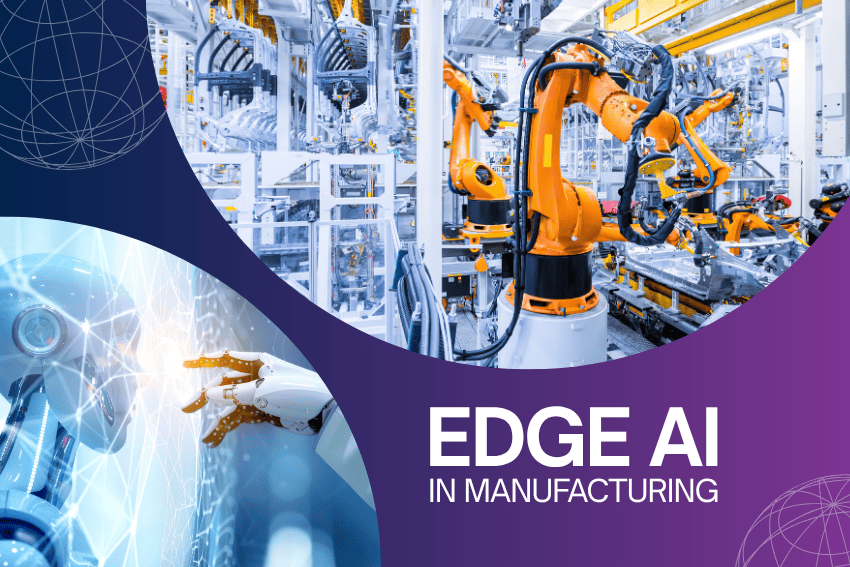Edge AI is reshaping the smart manufacturing landscape shifting the intelligence to the factory floors. This technology enables faster, smarter decisions by manufacturers as it processes the data at the edge where it is created, something that might not be done in cloud servers that are quite far. With edge AI, predictive maintenance, quality control, and more abilities to help with efficiency and innovation in Industry 4.0 are becoming a reality.

In this article, we’ll explore how this technology works, its key applications, and why it’s a game-changer for modern manufacturing.
What Is Edge AI in Manufacturing?
Edge AI combines artificial intelligence with edge computing, enabling devices like sensors, cameras, and machines to process data locally in real time. Unlike traditional cloud-based AI, which sends data to remote servers for analysis, Edge AI minimizes latency, reduces bandwidth costs, and enhances data privacy. In this smart manufacturing, it implies that factories can be instantly responsive to the requirements of the operations, including flaw identification and streamlining in production lines.
For example, imagine a robotic arm equipped with Edge AI analyzing sensor data to adjust its movements in milliseconds. Or a quality assurance mechanism that identifies a defective product before it goes out of an assembly line. And these functionalities are revolutionizing how the factories will be run and be more competitive and lean.
Why Edge AI Matters for Smart Manufacturing
The manufacturing industry is the land of accuracy, expediency, and consistency. Edge AI delivers all three by addressing challenges that traditional systems struggle with. It is due to this reason that it is becoming a necessity:
Real-Time Decision-Making
In factories, streams of data are produced per second. Transmission of all that information to cloud to do it there can be time-wasting, which is hair-raising to the time-sensitive operations. Edge AI processes data locally, enabling instant decisions—like shutting down a malfunctioning machine before it causes damage.
Cost Efficiency
By reducing reliance on cloud infrastructure, Edge AI lowers bandwidth and storage costs. Due to further optimization of energy consumption and reduced downtimes, manufacturers may save a lot of money as well.
Enhanced Data Security
Sensitive manufacturing data, like proprietary designs or production metrics, stays on-site with Edge AI. This minimizes any possibility of cyberattacks or data breach that might happen when using clouds in transmission of data.
Scalability
Edge AI systems are modular and can be deployed across multiple factory locations. The technology could be applied on a small scale, such as individual machine, or large-scale production line.
Key Applications of Edge AI in Smart Manufacturing
Edge AI is versatile, powering a wide range of applications that enhance every aspect of manufacturing. The following are some of the most effective usage cases:
Predictive Maintenance
Machines equipped with Edge AI analyze sensor data—like vibration, temperature, or noise—to predict when equipment might fail. This enables the manufacturers to do the maintenance in a proactive way therefore minimizing the unplanned downtimes. For instance, a steel plant using Edge AI can detect wear in a furnace and address it before a costly breakdown occurs.
Quality Control
Edge AI-powered vision systems inspect products in real time, identifying defects with greater accuracy than human inspectors. In electronics manufacturing, for example, cameras with Edge AI can spot microscopic flaws in circuit boards, ensuring only perfect products reach customers.
Process Optimization
By analyzing data from production lines, Edge AI identifies bottlenecks and inefficiencies. It has the ability to alter machine settings, optimize processes made, or even give improvements in layout to increase throughput. A food processing plant might use Edge AI to optimize packaging speeds based on real-time demand.
Worker Safety
Edge AI enhances workplace safety by monitoring environments for hazards. AI devices can monitor fatigue in employees using their wearable devices, whereas unsafe actions can be noted by cameras such as those employees going to prohibited areas. This makes the factory safer and more productive.
Integrated Supply Chain
Edge AI connects manufacturing with supply chain operations, enabling real-time inventory tracking and demand forecasting. For example, a car manufacturer can use Edge AI to adjust production schedules based on supplier delays, minimizing disruptions.
Benefits of Edge AI for Manufacturers
There are practical benefits of using Edge AI that fits the objectives of smart manufacturing:
- Improved Productivity: Frequent processing of data translates to efficient processes and increased productivity.
- Minimized Downtime: Downtimes due to unexpected failure would be prevented by the predictive maintenance and real-time monitoring.
- Enhanced Products Quality: With AI-assisted checks, there will be consistency and reduced waste.
- Sustainability: Energy savings generated by optimized processes, contribute to green practices.
- Competitive Advantage: Companies that embrace Edge AI first will gain a competitive advantage, as they will be able to take faster products with higher quality to the market.
Challenges and Considerations
While Edge AI is the game-changer, it is not immune to challenges. This is what manufacturers have to contend with in order to make the most of the technology:
- Initial Investment: The implementation of Edge AI implies the expenses related to equipment, programs, and training.
- Complication of Integration: The process of integrating legacy systems with Edge AI might be quite demanding.
- Skill Gaps: The staff has to be trained to master the use and support of AI-based systems.
- Data Management: Data at the edge should be accurate and consistent to reliable results.
The manufacturers can start small, initiating pilot projects, collaborating with AI vendors, and spending on worker upskilling to counter such challenges.
The Future of Edge AI in Manufacturing
As Edge AI evolves, its impact on smart manufacturing will only grow. The rising hardware development, such as more potent edge devices, will see to it that even intricate AI models can be executed locally. This will be even lower when integrated with 5G networks which enable new opportunities of having real-time collaboration across the factories. Also, AI algorithms will be more advanced which means that they will provide more insights and automation.
Imagine fully autonomous factories where Edge AI orchestrates every process, from raw material handling to final packaging. Although this vision is more years away, it is taking place in laying the foundation today.
Why Now Is the Time to Embrace Edge AI
The industry of manufacturing has reached a critical point. Increasing competition, supply chain interruption and the demand of customers to be able to customize products require manufacturers to deploy tools that could offer agility and precision. Edge AI is that tool, enabling factories to operate smarter, faster, and more sustainably.
By adopting Edge AI now, manufacturers can stay ahead of the curve, reduce costs, and unlock new revenue streams. This technology provides a solution in terms of resilience and growth in the industry 4.0 no matter whether you are a small factory or a global enterprise.
Conclusion
Edge AI is not merely a technological trend, but an evolutionary change of how smart manufacturing is reshaping its industrial practice. It brings intelligence to the factory floor and can enable manufacturers to enjoy a level of efficiency, quality, and innovation never before realized.
The pros definitely outweigh the cons, with integration issues and costs the only challenges that should pose a problem to those interested in improving operational progress through Edge AI.
Since technology is going to keep evolving, applying it now will leave those in the best positioned to dominate tomorrow. It is high time to invest in Edge AI to achieve the full potential of smart manufacturing.
FAQs
What is Edge AI in smart manufacturing?
Edge AI can be used to define artificial intelligence that is carried out locally on processes such as sensors or machines, which supports real-time research in manufacturing processes without the use of a cloud server.
How does Edge AI improve factory efficiency?
Edge AI is more efficient as it minimizes the downtime and makes the process more productive as it is able to optimize real-time processes, predictive maintenance, and quality checks.
Is Edge AI secure for manufacturing data?
Yes, Edge AI can be a better protection against security breaches since highly confidential data can be stored locally and does not require uploading to the cloud.
What are the costs of implementing Edge AI?
Depending on scale, costs include hardware software and training. Pilot projects, when applied to manufacturers, can support the testing of Edge AI at a low cost before complete implementation.
Can small manufacturers use Edge AI?
Absolutely. Edge AI also has the benefit of being scalable so that a small factory could initially use it in applications such as quality control or maintenance and later scale it.


